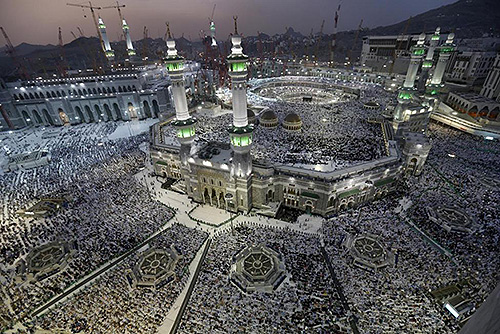Hajj From Indian Outlook
The significance of the region, Hejaz, is not in the number of pilgrims gather in Mecca but in the political and religious outlook of it. Huge numbers of Muslim Pilgrims congregate in the cities like Mecca and Medina. Muslims of India are not exceptions as well; many Indian Muslim pilgrims reach Mecca on the auspicious occasion during Hajj to feel the divinity.

Jeddah port, the famous gateway to the Mecca, was also a busy business port which had attracted merchants and pilgrims over the years. India has always provoked the people of Hejaz with its fascinating and bright pearls, precious stones, silks. The people of Hejaz looked forward to welcome Indian ships with spices, sandalwoods and perfumes.
Even though the primeval visits of Indian Muslims to Mecca (Makah) is a subject to surmise but most probably these visits were scheduled before the Muslim conquests of Sindh in 664-712 AD.
During the Mogul dynasty, Indian Muslim pilgrims used to travel by the overland caravan or by the ships. However, most of the pilgrims preferred to visit Mecca by ships. But the journey through Persian Gulf or Red Ocean was tough and perilous due to the presence of Portuguese. Indian ships traveling through the Portuguese territories in 16th century were forced to carry Portuguese cartaz.
Mogul rulers patronized the Hajj and tried many times to make the journey to Mecca very special and smooth. On various occasions, Mogul emperors had sent ships to guide pilgrims properly to Mecca. The prime embarkation port at Surat, Gujrat, was known as Bab-ul-Makkah. The Mogul emperor, Akbar, allowed free transportations to the port of Jeddah and had appointed one senior and dignified individual (leader of pilgrims) to show pilgrims the actual way. Regular charity was sent to the Mecca when the emperor Shah Jahan was the ruler.
The history of India says that especially Mogul emperors were fond of Hajj. The king Aurangzeb was known for his devout approach. He used to sponsor two of his royal ships every year which used to travel all the way to Mecca with huge numbers of pilgrims. Some people were forced and some wanted to go to Mecca intentionally during Mogul dynasty. Religious obligations, religious studies, rewards for good works, punishments for failures were some of the reasons for which Muslim pilgrims used to visit Mecca. Challengers and antagonists were also sent to Mecca into political exile.
The matter of the fact is that no significant or insignificant Muslim ruler had ever visited Mecca on Hajj. However, royal women were sent on Hajj.
Bega Begam or Haji Begam, one of the first royal ladies, had performed Hajj. Gulbadan Begam, the daughter of the emperor Babar, Salima Begam, a wife of the king Akbar, and 40 other women boarded on ship to Mecca in 1576 AD.
Various other prominent royal women visited Mecca on Hajj during 1661 to 1904 AD.
The king of Rampur, Kalbe Ali Khan, had performed Hajj in 1872 AD and rare manuscripts were brought to India. Unique and singular 7th century parchment manuscript of the Quran of 4th Caliph Ali was brought from Mecca. The well known Urdu Poet Dagh Dehlavi accompanied the king Kalbe Ali Khan.
The journey to Mecca on Hajj continued even after the death of the last Mogul king. When British were ruling India, they had appointed the travel agent "Thomas Cook" to accompany Hajj pilgrims. Many years later British also formed numerous committees to promote Hajj and guide Hajj pilgrims.
Reserve Bank of India issued and dedicated two special Hajj notes of denominations 10 and 100 rupees to Hajj pilgrims in 1959. These notes could be converted into Indian rupees and into the pounds sterling of Saudi Arab. Hajj pilgrims were allowed to carry different monitory amounts to Mecca depending on the choice of travelling classes. They could carry 1200 rupees in "Deck Class", 1800 rupees in "First Class" or 1700 rupees if pilgrims travel by air.
In 1950s and 1960s, unlike the present situation, the choice of selecting moallims or mutawifs (pilgrim guides) was solely dependent on the pilgrims themselves. Moallims were frequent travelers to various parts of the world to book tourists. A supervisor used to control and supervise the moallims. Until the mid 1970s the Saudi Government had cannibalized the service of scouts from all over the world during Hajj.
Mogul Line was the largest shipping line which was operating from Indian ports and was founded in 1888. In 1927, 20,000 Indian pilgrims out of 36,000 pilgrims had opted for the mogul lines. In 1930s more than 70% pilgrims were sailed to Mecca by Mogul vessels. Over a period of 10 years from 1958 to 1968, approximately 200,100 Muslim pilgrims arrived at Mecca for Hajj from India. India was ranked third (after Yemen and United Arab Republic) according to the numbers of pilgrims who had visited Mecca for Hajj during that period.
In 1960s, almost 14,500 Indian Muslim pilgrims had travelled to Mecca by sea where as 1000 pilgrims visited Mecca by Air India chartered flights. The company "Trade Wings" was responsible for the chartering of flights. Bombay was the place where both the ships and flights embarkations were accomplished. The price of the round trip on ships varied according to the class and comfort levels.
However, at present, almost all the pilgrims who visit Mecca during Hajj prefer to travel by air.

 Mother's Day
Mother's Day Passover
Passover Good Morning
Good Morning